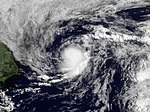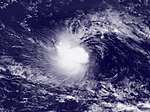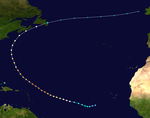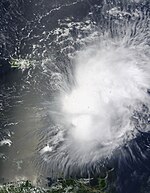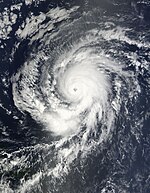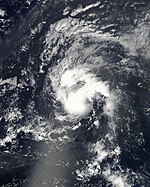2009 Atlantic hurricane season
Template:Infobox hurricane season active
The 2009 Atlantic hurricane season is an event in the annual cycle of tropical cyclone formation. The season officially started on June 1 and will end on November 30. These dates conventionally delimit the period of each year when most tropical cyclones form in the Atlantic basin.
The season began early with the development of Tropical Depression One on May 28, but for the next two months the Atlantic basin went dormant. On August 12, Tropical Storm Ana developed in the vicinity of the Cape Verde Islands, marking the latest date since 1992 when the season's first tropical cyclone was named in the Atlantic basin.[1] Tropical Storm Claudette formed on August 16 and became the first storm of the season to make landfall in the United States early the next morning. Hurricane Bill became the first hurricane and first major hurricane of the season. Hurricane Fred was unusual as it was the strongest hurricane so far south and east in the NHC's data record, as it reached major hurricane status about thirty-six hours after formation, becoming only the third known major hurricane east of 35°W. September's activity was below average in the basin this season, with only two named storms forming, Erika and Fred. September's ACE value was the lowest for the month since 1994, and the sixth lowest for the month since 1944.
Seasonal forecasts
| Source | Date | Named storms |
Hurricanes | Major hurricanes | |
| Average (1950–2000) | 9.6 | 5.9 | 2.3 | ||
| Record high activity | 28 | 15 | 8 | ||
| Record low activity | 4 | 2 | 0† | ||
| ––––––––––––––––––––––––––––––––––––––––––––––––––––––– | |||||
| CSU | December 10, 2008 | 14 | 7 | 3 | |
| CSU | April 7, 2009 | 12 | 6 | 2 | |
| NOAA | May 21, 2009 | 9–14 | 4–7 | 1–3 | |
| CSU | June 2, 2009 | 11 | 5 | 2 | |
| UKMO | June 18, 2009 | 6* | N/A | N/A | |
| CSU | August 4, 2009 | 10 | 4 | 2 | |
| NOAA | August 6, 2009 | 7–11 | 3–6 | 1–2 | |
| –––––––––––––––––––––––––––––––––––––––––– | |||||
| Actual activity | 8 | 2 | 2 | ||
| * July-November only. † Most recent of several such occurrences. (See all) | |||||

Forecasts of hurricane activity are issued before each hurricane season by noted hurricane experts Philip J. Klotzbach, William M. Gray, and their associates at Colorado State University; and separately by NOAA forecasters.
Klotzbach's team (formerly led by Gray) defined the average number of storms per season (1950 to 2000) as 9.6 tropical storms, 5.9 hurricanes, 2.3 major hurricanes (storms reaching at least Category 3 strength in the Saffir-Simpson Hurricane Scale) and ACE Index 96.1.[2] NOAA defines a season as above-normal, near-normal or below-normal by a combination of the number of named storms, the number reaching hurricane strength, the number reaching major hurricane strength and ACE Index.[3]
Pre-season forecasts
On December 10, 2008, Klotzbach's team issued its first extended-range forecast for the 2009 season, predicting above-average activity (14 named storms, 7 hurricanes, 3 of Category 3 or higher and ACE Index of 125). On April 7, 2009, Klotzbach's team issued an updated forecast for the 2009 season, predicting near-average activity (12 named storms, 6 hurricanes, 2 of Category 3 or higher and ACE Index of 100), citing the possible cause as the high probability of a weak El Niño forming during the season.[4] On May 21, 2009, NOAA issued their forecast for the season, predicting near or slightly above average activity, (9 to 14 named storms, 4 to 7 hurricanes, and 1 to 3 of Category 3 or higher).[5]
Midseason outlooks
On June 2, 2009, Klotzbach's team issued another updated forecast for the 2009 season, predicting slightly below average activity (11 named storms, 5 hurricanes, 2 of Category 3 or higher and ACE Index of 85). On June 18, 2009, the UK Met Office (UKMO) issued a forecast of 6 tropical storms in the July to November period with a 70% chance that the number would be in the range 3 to 9. They also predicted an ACE Index of 60 with a 70% chance that the index would be in the range 40 to 80.[6] On August 4, 2009, Klotzbach's team updated their forcast for the 2009 season, again predicting slightly below average activity (10 named storms, 4 hurricanes, and 2 major hurricanes). On August 6, 2009, the NOAA also updated their forecast for the 2009 season, predicting below average activity (7-11 named storms, 3-6 hurricanes, and 1-2 major hurricanes).
Storms
Tropical Depression One
| Tropical depression (SSHWS) | |
| Duration | May 28 – May 29 |
|---|---|
| Peak intensity | 35 mph (55 km/h) (1-min); 1006 mbar (hPa) |
On May 28, the National Hurricane Center began issuing advisories on Tropical Depression One. The depression had formed about 400 miles (640 km) east-northeast of the Outer Banks of North Carolina. With relatively favorable conditions, the depression was forecast to strengthen into a tropical storm by early May 29 before dissipating over cooler waters shortly thereafter. However, the system did not reach tropical storm strength, and instead began to weaken rapidly later on the 29th.[7] The depression became extratropical at about 5 p.m. AST (2100 UTC) that same day,[8] and was absorbed by a frontal zone shortly thereafter.
Tropical Storm Ana
| Tropical storm (SSHWS) | |
| Duration | August 11 – August 16 |
|---|---|
| Peak intensity | 40 mph (65 km/h) (1-min); 1003 mbar (hPa) |
On August 11, Tropical Depression Two developed west of the Cape Verde Islands and was quickly forecasted to become a tropical storm. On August 13, however, exposure to upper level wind shear and dry air led to the storm degenerating into a remnant low. Still, the storm was forecasted to strengthen back into a depression.[9] The system's remnants did in fact regenerate into a tropical depression shortly after midnight. Just hours later the depression was upgraded into Tropical Storm Ana and tropical storm watches were issued for most of the Leeward Islands.[10] On August 16, Ana degenerated into a tropical wave again after an Air Force hurricane hunter aircraft found the storm to be very poorly organized and even further dissipation was predicted.[11] Overnight, Ana moved across the Leeward Islands with little change in intensity predicted. The storm was forecasted to track across the northeastern Caribbean Sea and approach Hispaniola by August 17. Dry air and moderate shear took their toll on Ana, and it dissipated over the northern Caribbean that day. Tropical Storm Ana was one of three tropical storms active on August 16.
Hurricane Bill
| Category 4 hurricane (SSHWS) | |
| Duration | August 15 – August 24 |
|---|---|
| Peak intensity | 135 mph (215 km/h) (1-min); 943 mbar (hPa) |
Late on August 12, a strong tropical wave associated with an area of low pressure moved off the African coast with deep layers of moisture observed.[12] Later that day, the wave became better organized with a low level circulation forming, but without any significant convection. That night, the area of convection became more concentrated, but wind shear increased since the previous advisory. On August 14, the disturbance strengthened more and its convective bands became stronger with better circulation, indicating that the disturbance would soon become a tropical depression. Later, on August 15, even though some of its deep convection dissipated, it was officially named Bill, the second named storm of the 2009 season. Early on August 17, an eye appeared on visible and infrared loops and Bill strengthened into a hurricane, the first of the 2009 season. Bill then briefly underwent an eyewall replacement cycle, as the eye had contracted to a half its original size. However, strengthening continued and, on the evening of August 18, Bill rapidly strengthened into a major hurricane. Bill was one of three tropical storms active on August 16. It lost tropical characteristics after making landfall on Newfoundland as a weakening Category 1 hurricane on August 24. The extratropical storm then raced eastward in the Atlantic, in open waters of the North Atlantic, later affecting the United Kingdom.
Tropical Storm Claudette
| Tropical storm (SSHWS) | |
| Duration | August 16 – August 18 |
|---|---|
| Peak intensity | 50 mph (85 km/h) (1-min); 1006 mbar (hPa) |
Tropical Storm Claudette formed as the fourth depression of the season in the eastern Gulf of Mexico on August 16. The disturbance developed rapidly and formation was not expected until just a few hours before its declaration as a tropical depression. As recently as nine hours before the storm's formation, the NHC gave the system a less than 30% chance of developing in the next 48 hours.[13] In an update statement issued at 12:15 p.m. EDT on August 16, 2009, Tropical Depression Four was upgraded to Tropical Storm Claudette based on NOAA radar in Tallahassee. Early on August 17, Claudette made landfall at the east end of Santa Rosa Island, Florida, with 50 mph winds. Later that day, the NHC issued its last public advisory on Claudette as it moved inland and weakened to a tropical depression. Advisories were continued by the Hydrometeorological Prediction Center. Tropical Storm Claudette was one of three tropical storms active on August 16.
Tropical Storm Danny
| Tropical storm (SSHWS) | |
| Duration | August 26 – August 29 |
|---|---|
| Peak intensity | 60 mph (95 km/h) (1-min); 1006 mbar (hPa) |
Danny formed from a tropical wave interacting with an area of low pressure north of Hispaniola on August 26, but was barely tropical.[14] It skipped tropical depression status and then generally moved to the northwest, until it was absorbed into a larger extratropical storm on August 29. A boy was swept away from the rough surfs of Danny and his body was found several days later.[15] The damages from Danny are unknown but assumed to be minor.
Tropical Storm Erika
| Tropical storm (SSHWS) | |
| Duration | September 1 – September 3 |
|---|---|
| Peak intensity | 60 mph (95 km/h) (1-min); 1004 mbar (hPa) |
Tropical Storm Erika formed on September 1 at 5 p.m. AST northeast of the Leeward Islands from a low pressure area that had formed from a tropical wave south-southeast of Cape Verde on August 26. The wave moved across the Atlantic, and weakened to low potential for formation, but, the wave reorganized to medium potential, then high potential. Finally, around midday on September 1, the NHC initiated advisories on Tropical Storm Erika, skipping depression status; the second storm of the year to do so. Erika strengthened to a peak of 60 mph late on September 1, but began to weaken early the next day. On September 3, Erika was degraded to a tropical depression and later became a remnant low.
Hurricane Fred
| Category 3 hurricane (SSHWS) | |
| Duration | September 7 – September 12 |
|---|---|
| Peak intensity | 120 mph (195 km/h) (1-min); 958 mbar (hPa) |
Tropical Depression Seven formed from a tropical wave south of Cape Verde on September 7. It strengthened later that day to become Tropical Storm Fred. Early the next day, under favorable conditions, Fred strengthened to a Category 1 hurricane and was expected to intensify further. Fred rapidly intensified through the evening and into the early morning hours, becoming a Category 2 hurricane just six hours after becoming a hurricane. It continued to strengthen into a second major hurricane that morning, becoming the strongest storm ever recorded so far south and east in the Atlantic basin in the satellite era, and only the third major hurricane on record east of 35°W.[16] Fred weakened soon afterwards due to vertical wind shear, and devolved into a remnant low on September 12. [17] On September 20 Fred's remnant low nearly dissipated southwest of Bermuda. [18] The remnant low persisted until moving over the southeastern United States. The remnant low was the main cause of the 2009 Georgia floods. [19] The floods left 10 fatalities and $500 million in damage. [20]
Tropical Depression Eight
| Tropical depression (SSHWS) | |
| Duration | September 25 – September 26 |
|---|---|
| Peak intensity | 35 mph (55 km/h) (1-min); 1008 mbar (hPa) |
Tropical Depression Eight formed from a tropical wave west of the Cape Verde Islands on September 25. [21] Tropical Depression Eight was forecast to become a tropical storm, briefly. [22] The depression moved northwest into cooler waters and degenerated into a tropical wave on September 26. [23] Other than minor squalls in Cape Verde, the depression did not affect any landmasses, and therefore did not cause any damage.
Tropical Storm Grace
| Tropical storm (SSHWS) | |
| Duration | October 4 – October 5 |
|---|---|
| Peak intensity | 70 mph (110 km/h) (1-min); 986 mbar (hPa) |
Tropical Storm Grace formed just northeast of the Azores on October 4 out of a previously non-tropical storm. It is the farthest-northeast-forming tropical storm in the Atlantic in the satellite era, breaking Vince's record from 2005.[24] It moved rapidly northwards, reaching peak winds of 70 mph (110 km/h) early on October 5 and was absorbed by a frontal system late that same day, while less than 100 miles from the southwestern coast of Ireland.
Tropical Storm Henri
| Tropical storm (SSHWS) | |
| Duration | October 6 – October 8 |
|---|---|
| Peak intensity | 50 mph (85 km/h) (1-min); 1005 mbar (hPa) |
Tropical Storm Henri formed on October 6 at 4:50 PM EST about 525 miles northeast of the Lesser Antilles. At the 11 PM EST advisory on October 7, due to Henri moving into an area of cooler water and higher shear, it weakened to a tropical depression. Henri decayed into a remnant low a day later. Currently there is a low chance of redevelopment of Henri.
Accumulated Cyclone Energy (ACE)
| ACE (104kt²) (Source) — Storm: | |||||||||||||
|---|---|---|---|---|---|---|---|---|---|---|---|---|---|
| 1 | 25.8 | Bill | 5 | 1.22 | Grace | ||||||||
| 2 | 9.81 | Fred | 6 | 0.858 | Ana | ||||||||
| 3 | 1.88 | Danny | 7 | 0.768 | Henri | ||||||||
| 4 | 1.27 | Erika | 8 | 0.528 | Claudette | ||||||||
| Total: 42.1 | |||||||||||||
The table on the right shows the ACE for each storm in the season. ACE is, broadly speaking, a measure of the power of the hurricane multiplied by the length of time it existed, so storms that last a long time as well as particularly strong hurricanes have high ACEs. ACE is only officially released for full advisories on tropical systems at or exceeding 34 knots (39 mph, 63 km/h) or tropical storm strength.
Timeline recent events

September
September 25
- 5:00 p.m. AST (2100 UTC) – Tropical Depression Eight forms west of Cape Verde.
September 26
- 5:00 p.m. AST (2100 UTC) - Tropical Depression Eight dissipates.
October
October 4
- 11 p.m. AST (0300 UTC October 5) - Tropical Storm Grace forms northeast of the Azores.
October 5
- 11 p.m. AST (0300 UTC October 6) - Tropical Storm Grace is absorbed by a front near Ireland.
October 6
- 3:15 p.m. EDT (1915 UTC) - Tropical Storm Henri forms northeast of the Lesser Antilles.
October 7
- 11:00 p.m. EDT (0300 UTC) - Tropical Storm Henri weakens into Tropical Depression Henri. [25]
October 8
- 5:00 p.m. EDT (2100 UTC) - Tropical Depression Henri weakens into a remnant low.
Storm names
The following names will be used for named storms that form in the North Atlantic in 2009. Retired names, if any, will be announced by the World Meteorological Organization in the spring of 2010. The names not retired from this list will be used again in the 2015 season. Names that were not used are marked in gray, and names in bold are storms currently active. This is the same list used in the 2003 season with the exception of Fred, Ida, and Joaquin, which replaced Fabian, Isabel, and Juan respectively. If there are more than 21 named storms (the 21st being Wanda) then any more tropical storm-strength systems will be named with the Greek alphabet, starting with Alpha. This has only occurred once, in 2005. The name Fred was used for an Atlantic storm the first time in 2009.
|
|
Season effects
This is a table of the storms in 2009 and their landfall(s), if any. Deaths in parentheses are additional and indirect (an example of an indirect death would be a traffic accident), but are still storm-related. Damage and deaths include totals while the storm was extratropical or a wave or low.
| Saffir–Simpson scale | ||||||
| TD | TS | C1 | C2 | C3 | C4 | C5 |
|- style="background:#6EC1EA" ! align=left | One | style="text-align:left;background:#FFFFFF; color:black" data-sort-value="May 28 , 2017" | May 28 – May 29 | style="text-align:center;" data-sort-value="5"|Tropical depression | style="text-align:center;" | 35 | style="text-align:center;" | 1006 | style="text-align:left;background:#FFFFFF; color:black" | {{{areas}}} | style="text-align:center;background:#FFFFFF; color:black" data-sort-value=""| {{{damage}}} | style="text-align:center;background:#FFFFFF; color:black" data-sort-value=""| {{{deaths}}} | style="text-align:right;background:#FFFFFF; color:black" data-sort-value="0"| Template:TC stats no landfall Template:TC stats impact
|- style="background:#4DFFFF" ! align=left | Ana | style="text-align:left;background:#FFFFFF; color:black" data-sort-value="August 11 , 2017" | August 11 – August 16 | style="text-align:center;" data-sort-value="8"|Tropical storm | style="text-align:center;" | 40 | style="text-align:center;" | 1003 | style="text-align:left;background:#FFFFFF; color:black" | {{{areas}}} | style="text-align:center;background:#FFFFFF; color:black" data-sort-value=""| {{{damage}}} | style="text-align:center;background:#FFFFFF; color:black" data-sort-value=""| {{{deaths}}} | style="text-align:right;background:#FFFFFF; color:black" data-sort-value="0"| Template:TC stats no landfall Template:TC stats impact
|- style="background:#FF738A" ! align=left | Bill | style="text-align:left;background:#FFFFFF; color:black" data-sort-value="August 15 , 2017" | August 15 – August 24 | style="text-align:center;" data-sort-value="40"|Category 4 hurricane | style="text-align:center;" | 135 | style="text-align:center;" | 943 | style="text-align:left;background:#FFFFFF; color:black" | {{{areas}}} | style="text-align:center;background:#FFFFFF; color:black" data-sort-value=""| {{{damage}}} | style="text-align:center;background:#FFFFFF; color:black" data-sort-value=""| {{{deaths}}} | style="text-align:right;background:#FFFFFF; color:black" data-sort-value="0"| Template:TC stats first landfall Template:TC stats impact Template:TC stats next landfall
|- style="background:#4DFFFF" ! align=left | Claudette | style="text-align:left;background:#FFFFFF; color:black" data-sort-value="August 16 , 2017" | August 16 – August 18 | style="text-align:center;" data-sort-value="8"|Tropical storm | style="text-align:center;" | 50 | style="text-align:center;" | 1006 | style="text-align:left;background:#FFFFFF; color:black" | {{{areas}}} | style="text-align:center;background:#FFFFFF; color:black" data-sort-value=""| {{{damage}}} | style="text-align:center;background:#FFFFFF; color:black" data-sort-value=""| {{{deaths}}} | style="text-align:right;background:#FFFFFF; color:black" data-sort-value="0"| Template:TC stats first landfall Template:TC stats impact
|- style="background:#4DFFFF" ! align=left | Danny | style="text-align:left;background:#FFFFFF; color:black" data-sort-value="August 26 , 2017" | August 26 – August 29 | style="text-align:center;" data-sort-value="8"|Tropical storm | style="text-align:center;" | 60 | style="text-align:center;" | 1006 | style="text-align:left;background:#FFFFFF; color:black" | {{{areas}}} | style="text-align:center;background:#FFFFFF; color:black" data-sort-value=""| {{{damage}}} | style="text-align:center;background:#FFFFFF; color:black" data-sort-value=""| {{{deaths}}} | style="text-align:right;background:#FFFFFF; color:black" data-sort-value="0"| Template:TC stats no landfall Template:TC stats impact
|- style="background:#4DFFFF" ! align=left | Erika | style="text-align:left;background:#FFFFFF; color:black" data-sort-value="September 1 , 2017" | September 1 – September 3 | style="text-align:center;" data-sort-value="8"|Tropical storm | style="text-align:center;" | 60 | style="text-align:center;" | 1004 | style="text-align:left;background:#FFFFFF; color:black" | {{{areas}}} | style="text-align:center;background:#FFFFFF; color:black" data-sort-value=""| {{{damage}}} | style="text-align:center;background:#FFFFFF; color:black" data-sort-value=""| {{{deaths}}} | style="text-align:right;background:#FFFFFF; color:black" data-sort-value="0"| Template:TC stats first landfall Template:TC stats impact
|- style="background:#FF9E59" ! align=left | Fred | style="text-align:left;background:#FFFFFF; color:black" data-sort-value="September 7 , 2017" | September 7 – September 12 | style="text-align:center;" data-sort-value="30"|Category 3 hurricane | style="text-align:center;" | 120 | style="text-align:center;" | 958 | style="text-align:left;background:#FFFFFF; color:black" | {{{areas}}} | style="text-align:center;background:#FFFFFF; color:black" data-sort-value=""| {{{damage}}} | style="text-align:center;background:#FFFFFF; color:black" data-sort-value=""| {{{deaths}}} | style="text-align:right;background:#FFFFFF; color:black" data-sort-value="0"| Template:TC stats no landfall Template:TC stats impact
|- style="background:#6EC1EA" ! align=left | Eight | style="text-align:left;background:#FFFFFF; color:black" data-sort-value="September 25 , 2017" | September 25 – September 26 | style="text-align:center;" data-sort-value="5"|Tropical depression | style="text-align:center;" | 35 | style="text-align:center;" | 1008 | style="text-align:left;background:#FFFFFF; color:black" | {{{areas}}} | style="text-align:center;background:#FFFFFF; color:black" data-sort-value=""| {{{damage}}} | style="text-align:center;background:#FFFFFF; color:black" data-sort-value=""| {{{deaths}}} | style="text-align:right;background:#FFFFFF; color:black" data-sort-value="0"| Template:TC stats no landfall Template:TC stats impact
|- style="background:#4DFFFF" ! align=left | Grace | style="text-align:left;background:#FFFFFF; color:black" data-sort-value="October 4 , 2017" | October 4 – October 5 | style="text-align:center;" data-sort-value="8"|Tropical storm | style="text-align:center;" | 70 | style="text-align:center;" | 986 | style="text-align:left;background:#FFFFFF; color:black" | {{{areas}}} | style="text-align:center;background:#FFFFFF; color:black" data-sort-value=""| {{{damage}}} | style="text-align:center;background:#FFFFFF; color:black" data-sort-value=""| {{{deaths}}} | style="text-align:right;background:#FFFFFF; color:black" data-sort-value="0"| Template:TC stats first landfall Template:TC stats impact
|- style="background:#4DFFFF" ! align=left | Henri | style="text-align:left;background:#FFFFFF; color:black" data-sort-value="October 6 , 2017" | October 6 – October 8 | style="text-align:center;" data-sort-value="8"|Tropical storm | style="text-align:center;" | 50 | style="text-align:center;" | 1005 | style="text-align:left;background:#FFFFFF; color:black" | {{{areas}}} | style="text-align:center;background:#FFFFFF; color:black" data-sort-value=""| {{{damage}}} | style="text-align:center;background:#FFFFFF; color:black" data-sort-value=""| {{{deaths}}} | style="text-align:right;background:#FFFFFF; color:black" data-sort-value="0"| Template:TC stats no landfall Template:TC stats impact Template:TC stats table end
See also
- List of Atlantic hurricanes
- List of Atlantic hurricane seasons
- 2009 Pacific hurricane season
- 2009 Pacific typhoon season
- 2009 North Indian Ocean cyclone season
- South-West Indian Ocean cyclone seasons: 2008–09, 2009–10
- Australian region cyclone seasons: 2008–09, 2009–10
- South Pacific cyclone seasons: 2008–09, 2009–10
References
- ^ Avila, Blake (2009-08-01). "Tropical Weather Summary". National Hurricane Center. Retrieved 2009-08-02.
- ^ Philip J. Klotzbach and William M. Gray (2008-12-10). "Extended Range Forecast of Atlantic Seasonal Hurricane Activity and U.S. Landfall Strike Probability for 2009". Colorado State University. Archived from the original (PDF) on 2009-06-12. Retrieved 2009-01-01.
{{cite web}}: Unknown parameter|deadurl=ignored (|url-status=suggested) (help) - ^ National Hurricane Center (May 22, 2008). "NOAA Atlantic Hurricane Season Classifications". National Oceanic and Atmospheric Administration. Retrieved April 14, 2009.
- ^ William M. Gray (2008-04-07). "Mid-Season Forecast of Atlantic Seasonal Hurricane Activity and U.S. Landfall Strike Probability for 2009" (PDF). Colorado State University. Retrieved 2009-04-07.
{{cite web}}: Text "o" ignored (help) - ^ Ruane, Michael E. (2009-05-21). "Government Weather Officials Predict Average 2009 Season". Washington Post. Retrieved 2009-08-16.
{{cite news}}: Cite has empty unknown parameter:|coauthors=(help) - ^ "UKMO North Atlantic tropical storms seasonal forecast for 2009".
- ^ Franklin and Beven (May 28, 2009). "Tropical Depression One Discussion Number 1". National Oceanic and Atmospheric Administration. Retrieved 2009-05-28.
- ^ Kimberlain and Franklin (May 29, 2009). "Tropical Depression One Discussion Number 6". National Oceanic and Atmospheric Administration. Retrieved 2009-06-01.
- ^ http://www.nhc.noaa.gov/archive/2009/al02/al022009.public.011.shtml?
- ^ http://www.nhc.noaa.gov/archive/2009/al02/al022009.public.018.shtml?
- ^ http://www.nhc.noaa.gov/archive/2009/al02/al022009.public.019.shtml?
- ^ Walton (2009-08-13). "Tropical weather discussion 205 AM EDT August 13 2009". National Hurricane Center. Archived from the original on 2009-08-22. Retrieved 2009-08-16.
{{cite web}}: Unknown parameter|deadurl=ignored (|url-status=suggested) (help) - ^ Tropical Weather Outlook 800 PM EDT August 15, 2009.National Hurricane Center, Avila and Kimberlain (August 15, 2009). National Oceanic and Atmospheric Administration. Retrieved 2009-08-16.
- ^ Jack Beven (2009-08-26). "Tropical Storm Danny discussion number 1". National Hurricane Center. Archived from the original on 2009-09-09. Retrieved 2009-08-27.
{{cite web}}: Unknown parameter|deadurl=ignored (|url-status=suggested) (help) - ^ "Body of boy missing off Outer Banks recovered". WRAL. WRAL. September 1, 2009. Archived from the original on 2009-09-09. Retrieved 2009-09-01.
{{cite news}}: Unknown parameter|deadurl=ignored (|url-status=suggested) (help) - ^ HURRICANE FRED DISCUSSION NUMBER 8, National Hurricane Center, 1100 AM AST WED SEP 09 2009. Accessed 2009-09-10. Archived 2009-09-12.
- ^ "Tropical Depression FRED Public Advisory". Archived from the original on 2009-09-16. Retrieved 2009-09-12.
{{cite web}}: Unknown parameter|deadurl=ignored (|url-status=suggested) (help) - ^ Brown, Daniel (20 September 2009). "Graphical Tropical Weather Outlook". National Hurricane Center. Retrieved 2009-09-22.
- ^ http://www.webcitation.org/5k2Wbw8LB
- ^ "Atlanta flood update 2: Damages doubled, more counties declared disaster areas". Archived from the original on 2009-10-01. Retrieved 2009-09-28.
{{cite web}}: Unknown parameter|deadurl=ignored (|url-status=suggested) (help) - ^ "Tropical Depression EIGHT". Archived from the original on 2009-10-01. Retrieved 2009-09-28.
{{cite web}}: Unknown parameter|deadurl=ignored (|url-status=suggested) (help) - ^ http://www.nhc.noaa.gov/archive/2009/al08/al082009.discus.002.shtml?
- ^ http://www.nhc.noaa.gov/archive/2009/al08/al082009.public.005.shtml?
- ^ Tropical Storm Grace races northeast in Atlantic, Reuters 2009-10-05, retrieved 2009-10-05
- ^ http://www.nhc.noaa.gov/archive/2009/al10/al102009.public.006.shtml?

